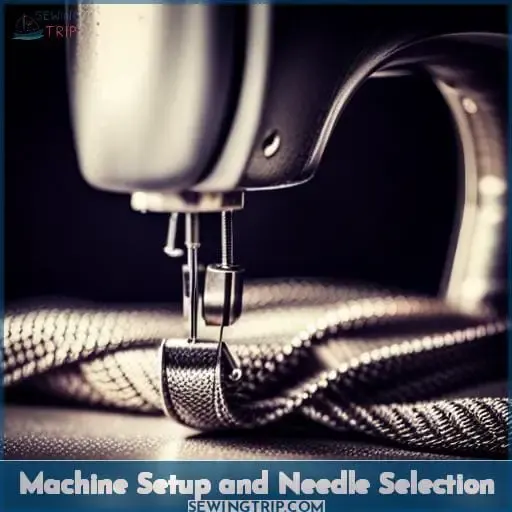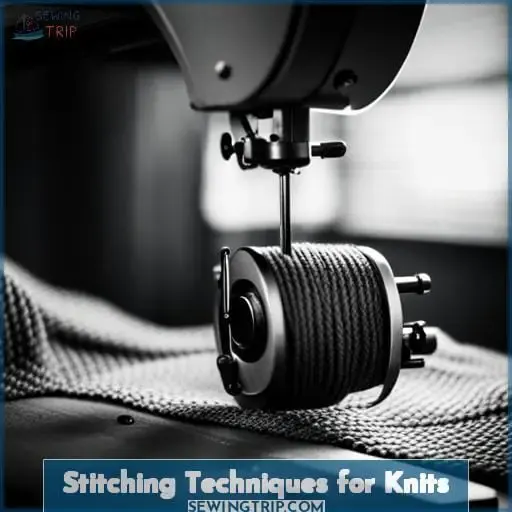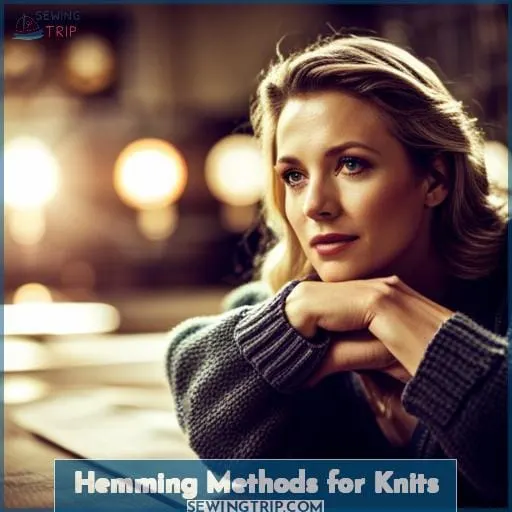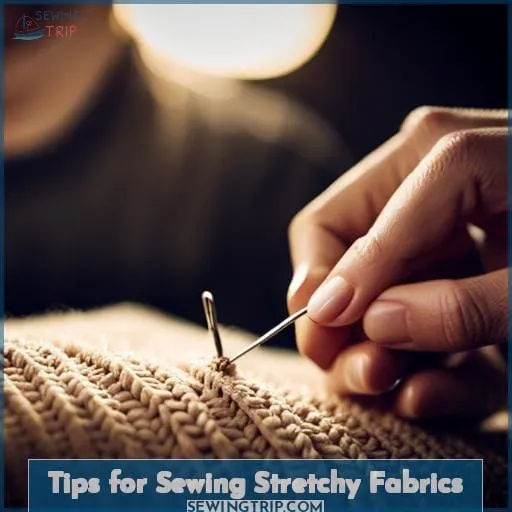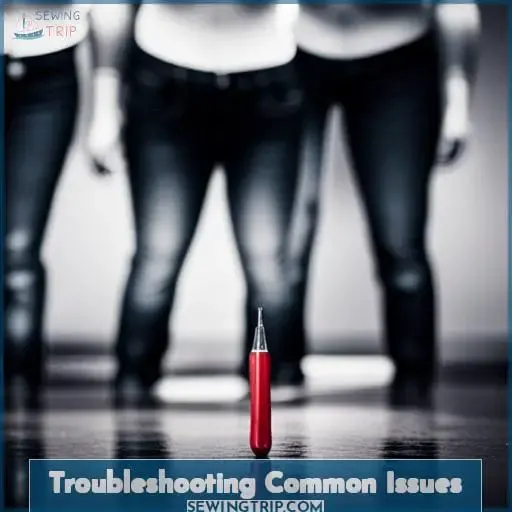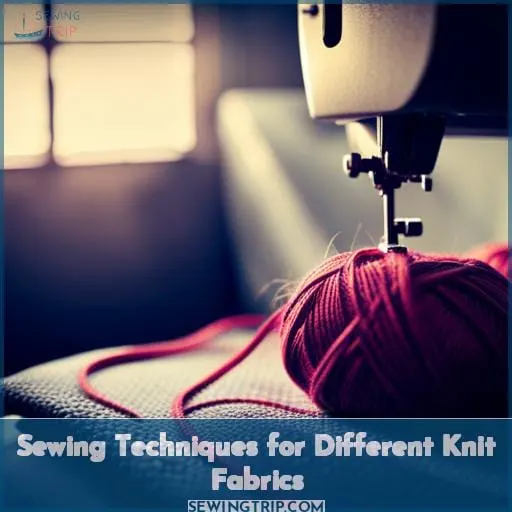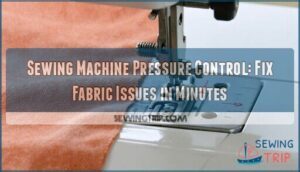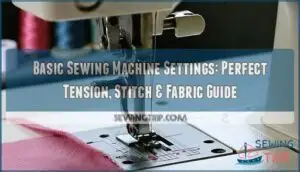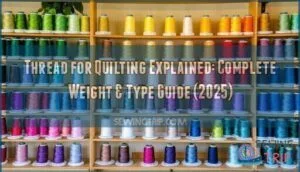This site is supported by our readers. We may earn a commission, at no cost to you, if you purchase through links.
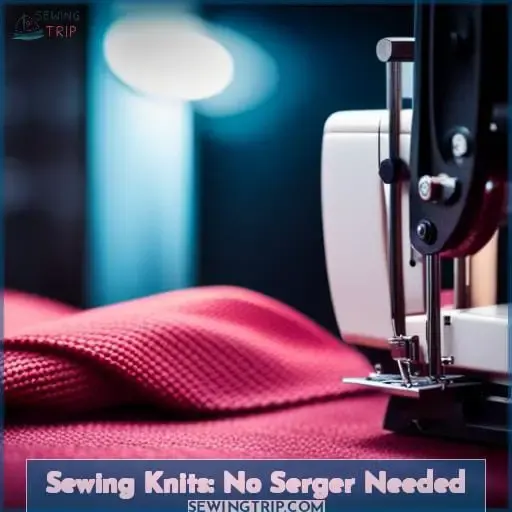 Immerse yourself in the world of sewing knits without the need for a serger. Discover techniques that will unlock your creativity and give you the confidence to tackle any knit project.
Immerse yourself in the world of sewing knits without the need for a serger. Discover techniques that will unlock your creativity and give you the confidence to tackle any knit project.
From machine setup to stitching techniques, hemming methods, and troubleshooting tips, this article is your ultimate guide to sewing knits with ease.
Embrace the stretchy nature of knit fabrics as you learn how to handle them like a pro using just your regular sewing machine.
Get ready for a whole new level of mastery in garment construction!
Table Of Contents
Key Takeaways
- Choose ballpoint needles for most knits.
- Experiment with stitch length and width to achieve desired results.
- Use a walking foot for even feeding of fabric.
- Use a zigzag stitch for stretchy fabrics.
Machine Setup and Needle Selection
Now, let’s talk about setting up your sewing machine and selecting the right needle for sewing knits without a serger.
Choosing the correct needle is crucial to ensure smooth stitching on knit fabrics. Opt for ballpoint needles for most knits, while stretch needles are ideal for spandex or Lycra blends.
Additionally, adjusting the presser foot pressure will help prevent fabric stretching during sewing.
Choosing the Right Needle
When sewing knits without a serger, it’s important to start by choosing the right needle for your machine setup.
Here are five discussion ideas about choosing the right needle:
- Fabric compatibility
- Needle sizing
- Thread interaction
- Precision stitching
- Seam strength
Consider using stretch needles or ballpoint needles for knit fabrics to ensure smooth stitching and prevent damage to the fabric.
Proper needle selection is crucial when working with stretchy materials like knits.
Adjusting Presser Foot Pressure
To ensure smooth and even stitching on knit fabrics, adjust the presser foot pressure on your sewing machine.
Here are five discussion ideas about adjusting presser foot pressure that aren’t covered in the other listed subtopics:
- Fabric Interaction: Different knits may require different presser foot pressures to prevent stretching or puckering.
- Tension Balance: Adjusting the presser foot pressure can help achieve balanced tension between upper and lower threads.
- Material Thickness: Thicker knits may need higher presser foot pressure for better fabric control during sewing.
- Stitch Consistency: Properly adjusted presser foot pressure ensures consistent stitch formation across different areas of your project.
- Machine Compatibility: Not all machines have adjustable presser feet.
Stitching Techniques for Knits
Now, let’s explore some essential stitching techniques for sewing knits without a serger.
The three main stitches to focus on are the zigzag stitch, overlock stitch, and reinforced straight stitch. These stitches will help ensure secure seams and prevent unraveling in knit fabrics.
Let’s dive into each technique and discuss how to achieve professional-looking results with your regular sewing machine.
Zigzag Stitching
Start by setting your sewing machine to a zigzag stitch with a width of 5 and length of 1/5.
Zigzag stitching is perfect for stretch fabrics, as it allows the seam to stretch without breaking. Adjust the thread tension according to your fabric’s stretchiness for optimal results.
When using this stitch technique, you can also use it decoratively or for edge finishing on knit fabric seams.
Get ready to unleash your creativity and master sewing with knits!
Overlock Stitching
Now, let’s dive into the technique of overlock stitching for sewing knits without a serger.
- Adjust thread tension: Ensure proper tension to prevent loose or tight stitches.
- Enhance seam strength: Overlock stitching provides added durability and prevents unraveling.
- Consider fabric compatibility: Test the stitch on scrap fabric to ensure it works well with your specific knit material.
Reinforced Straight Stitch
Get ready to reinforce your knit seams with the versatile and durable reinforced straight stitch.
To achieve the best results, use a walking foot for even feeding and prevent fabric stretching.
Test different stitch widths and lengths on scrap fabric to find the perfect setting for your project.
Remember to backstitch at the beginning and end of each seam for added security.
While a serger can provide a clean finish, trimming seam allowances will give your garment a polished look.
Hemming Methods for Knits
Now that you’ve mastered stitching techniques for knits, it’s time to explore hemming methods.
When working with knit fabrics without a serger, there are three popular approaches to consider:
- The single fold hem
- The twin needle hem
- The narrow zigzag hem
Each method offers its own unique benefits and can help achieve a professional finish on your knit projects.
Let’s take a closer look at these options and how they can elevate your sewing skills with knits.
Single Fold Hem
To achieve a clean and professional finish on your knit garments, try the single fold hem technique.
-
Purpose:
The single fold hem provides a neat and finished edge to prevent fraying or unraveling of knit fabric.
-
Applications:
This technique can be applied to various types of knit garments, such as t-shirts, dresses, skirts, or even cuffs and hems.
-
Pros and Cons:
The single fold hem is relatively easy to execute with basic sewing skills but may require practice for precision stitching on stretchy fabrics.
-
Tips and Tricks:
Use knitting needles or pins to help maintain an even width while folding the fabric over itself before stitching.
Mastering the art of the single fold hem will elevate your sewing projects by giving them that polished look they deserve!
Twin Needle Hem
To achieve a professional and polished finish on your knit garments, one effective hemming method to consider is using a twin needle.
This technique involves using two needles simultaneously on your sewing machine for parallel rows of stitching.
The result is a neat and sturdy double line of stitching that adds both style and durability to the hemline.
It’s important to use matching thread for seamless blending with the fabric, ensuring that the stitches are virtually invisible from the right side of the garment.
Experiment with different types of stretchy fabrics to find what works best with this technique.
Topstitching can also be added along the edges for an extra decorative touch.
Narrow Zigzag Hem
Now let’s explore the technique of hemming knits using a narrow zigzag stitch.
The narrow zigzag hem is an excellent choice for stretchy fabrics, especially when you don’t have access to a serger.
Set your sewing machine to a medium-length stitch (around 2-3) and adjust the stitch width according to your preference.
This method provides stability while allowing for some flexibility in the finished hem.
Tips for Sewing Stretchy Fabrics
When working with stretchy fabrics, it’s important to handle the fabric’s stretch properly.
Start by using ballpoint pins, which are designed specifically for knits and won’t damage the fabric.
Additionally, support the weight of the fabric while sewing to prevent stretching or distortion during stitching.
Handling Fabric Stretch
Handle fabric stretch with care to ensure smooth and even stitching results.
When sewing stretchy fabrics, there are a few key tips to keep in mind:
- Use ballpoint pins: These pins have rounded tips that glide through the fabric without snagging or damaging it.
- Avoid stretching the fabric: Gently guide the fabric through your machine without pulling or tugging on it.
- Match needle size to fabric: Choose a needle size based on the weight and stretch percentage of your knit fabric for optimal stitch quality.
Remember these tips when working with knit fabrics to achieve professional-looking results every time!
Using Ballpoint Pins
When sewing stretchy fabrics, it’s important to use ballpoint pins for better results.
Unlike regular pins, ballpoint pins have a rounded tip that slides between the knit fibers without damaging them.
Ballpoint pins are also superior to safety pins or wonder clips because they securely hold the fabric in place without distorting its shape.
Make sure to use these specialized tools when working with knit fabric for optimal sewing success.
Supporting Fabric Weight
To ensure smooth stitching and prevent fabric distortion, support the weight of your stretchy knit fabric while sewing by using a combination of proper machine setup and manual assistance.
- Use a walking foot or feed dogs to evenly move the fabric through the machine.
- Adjust stitch width for optimal results based on your needle size and knit fabric weight.
- Consider using pins or weights to hold down the edges of your project as you sew.
Troubleshooting Common Issues
Now let’s address some common issues you may encounter while sewing knits without a serger.
One issue you might face is puckering, where the fabric gathers or wrinkles along the seam line. To prevent this, make sure to use ballpoint needles and test your machine settings on scrap fabric before starting your project.
Another problem could be stretching of the fabric while sewing, resulting in uneven seams. To avoid this, support the weight of the fabric as you sew and be mindful not to stretch or resist against the machine feed.
Lastly, we’ll discuss different options for finishing seams on knit fabrics without a serger to ensure clean and professional-looking results.
Puckering and Stretching
If you’re experiencing puckering and stretching while sewing knits without a serger, here’s how to troubleshoot these common issues:
- Pinning:
- Use pins sparingly and strategically to prevent fabric distortion.
- Fabric Handling:
- Avoid overstretching the fabric during sewing by supporting it properly.
- Separating Layers:
- Separate layers of knit fabrics when stitching to prevent puckering.
- Pressing:
- Press seams after stitching to reduce puckering and create neater results.
By implementing these techniques, you can sew stretchy fabric without worrying about puckering or stretching issues.
Seam Finishing Options
To address any puckering or stretching issues you may encounter while sewing knits, it’s important to explore different seam finishing options.
Here are some common techniques for finishing seams in knit fabrics:
| Seam Finishing Options | Stitch Type |
|---|---|
| Zigzag stitch | |
| Overlock stitch | |
| Reinforced straight stitch |
These options provide varying degrees of stretch and stability, allowing you to choose the best method based on the fabric and desired outcome.
Sewing Techniques for Different Knit Fabrics
Now that you have a solid understanding of the basics, let’s dive into sewing techniques for different types of knit fabrics.
There are three main categories we’ll discuss:
- Light and medium knits
- Heavy and stable knits
- Stretchy and Lycra blends
Each type requires specific considerations when it comes to:
- Needle selection
- Stitch choice
- Seam finishing methods
- Hemming techniques
By understanding how to work with each type effectively without a serger machine , you’ll be able to confidently sew your favorite knit garments with professional-looking results!
Light and Medium Knits
Sew light and medium knits with ease using these effective techniques:
- Adjust presser foot pressure: Reduce the pressure to prevent stretching.
- Use a stretch stitch: Opt for a narrow zigzag or lightning bolt stitch for added stretch.
- Consider walking foot attachment: It helps feed the fabric evenly, preventing distortion.
These lightweight fabrics are perfect for casual wear as they drape well, create great silhouettes, and hold their shape without stretching out.
Heavy and Stable Knits
When working with heavy and stable knits, mastering the proper sewing techniques is essential for achieving professional results. These types of fabrics require adjustments in machine settings and stitching techniques to ensure successful outcomes.
When sewing heavy knits, consider using a slightly longer stitch length to accommodate the fabric weight. Additionally, use a reinforced straight stitch or zigzag stitch for stronger seams. Explore alternative methods like topstitching with twin needles for added durability and decorative effects on these sturdy knit fabrics.
Stretchy and Lycra Blends
For sewing stretchy and Lycra blends, adjust your machine settings accordingly.
- Handling: Take extra care when handling the fabric to prevent stretching.
- Support: Ensure proper support for the fabric weight while sewing to avoid distortion.
- Puckering: Adjust stitch length and tension to prevent puckering on stretchy fabrics.
- Needle Choice: Use ballpoint or stretch needles designed specifically for knit fabrics.
With these techniques, you’ll be able to confidently sew beautiful garments with stretchy fabrics like spandex and lycra.
Final Touches and Finishing Details
Now that you’ve successfully sewn your knit garment without a serger, it’s time to add those final touches and finishing details.
Pressing seams is essential for achieving a professional look – use steam or a pressing cloth to flatten and shape the fabric.
When topstitching, choose an appropriate stitch length (around 3mm) and thread color that complements your garment.
Lastly, secure all seams with backstitching to ensure durability and prevent unraveling.
Pressing Seams
To achieve a polished finish on your knit garments, press the seams with a steam iron.
The heat and steam will help set the stitches and flatten any wrinkles or puckering.
Place a piece of parchment paper between the fabric and iron to prevent shine marks.
Use an ironing board for stability and adjust the fabric presser foot pressure settings according to your machine’s instructions.
Pressing is an essential step in garment construction that adds that professional touch before moving on to hemming techniques.
Topstitching Tips
Now let’s delve into the important aspect of topstitching to add those final touches and finishing details to your knit projects.
When it comes to topstitching stretchy fabric, there are a few key tips to keep in mind.
- Use secure stitches like backstitching at the beginning and end of your seams for added durability.
- Consider using twin needles for a professional coverstitch look or utilize a zigzag stitch as a faux overlock option.
- Ensure smooth stitching by using an even feed foot or walking presser foot while sewing knit fabrics without a serge.
Securing Seams With Backstitching
To ensure the durability and longevity of your knit projects, it’s essential to secure seams with backstitching. This technique helps prevent unraveling and ensures that your stitches stay in place even with the stretchiness of knit fabric.
When backstitching on knits, consider the following:
- Use a needle size appropriate for your fabric weight.
- Adjust stitch length to accommodate fabric stretch.
- Begin and end each seam with several backstitches for added reinforcement.
- Trim excess thread tails close to the stitching line for a clean finish.
Frequently Asked Questions (FAQs)
Can I use a regular sewing machine to sew knits without a serger?
Absolutely! You certainly can use a regular sewing machine to sew knits without a serger.
- Choose the right needles.
- Adjust your machine settings.
- Use appropriate stitching techniques.
How do I prevent my knit fabric from stretching while sewing?
Prevent knit fabric from stretching while sewing by:
- Adjusting presser foot pressure
- Using a walking foot
- Experimenting with needle size, stitch length, and width
Take control of your knits!
What type of needle should I use for different types of knit fabrics?
For different knit fabrics, use ballpoint/jersey needles to prevent snags and ensure smooth stitching.
Opt for stretch needles when working with spandex or Lycra blends.
Choose needle sizes based on fabric weight for optimal results.
Can I use a straight stitch instead of a zigzag stitch for sewing knits?
Yes, you can use a straight stitch for sewing knits, but it may not provide enough stretch.
A zigzag stitch is recommended to ensure durability and flexibility in your knit garments.
How do I finish the raw edges of knit fabric without a serger?
To finish the raw edges of knit fabric without a serger, try using:
- A narrow zigzag stitch
- A reinforced straight stitch
These techniques provide stability and prevent fraying, giving your project a polished look.
Conclusion
To sew knits without a serger, all you need is your regular sewing machine and the right techniques. By following the tips in this article, you can confidently handle and stitch knit fabrics like a pro.
From machine setup and needle selection to hemming methods and troubleshooting tips, you now have the knowledge to tackle any knit project. Embrace the stretchy nature of knits and enjoy the satisfaction of creating beautiful garments with ease.

